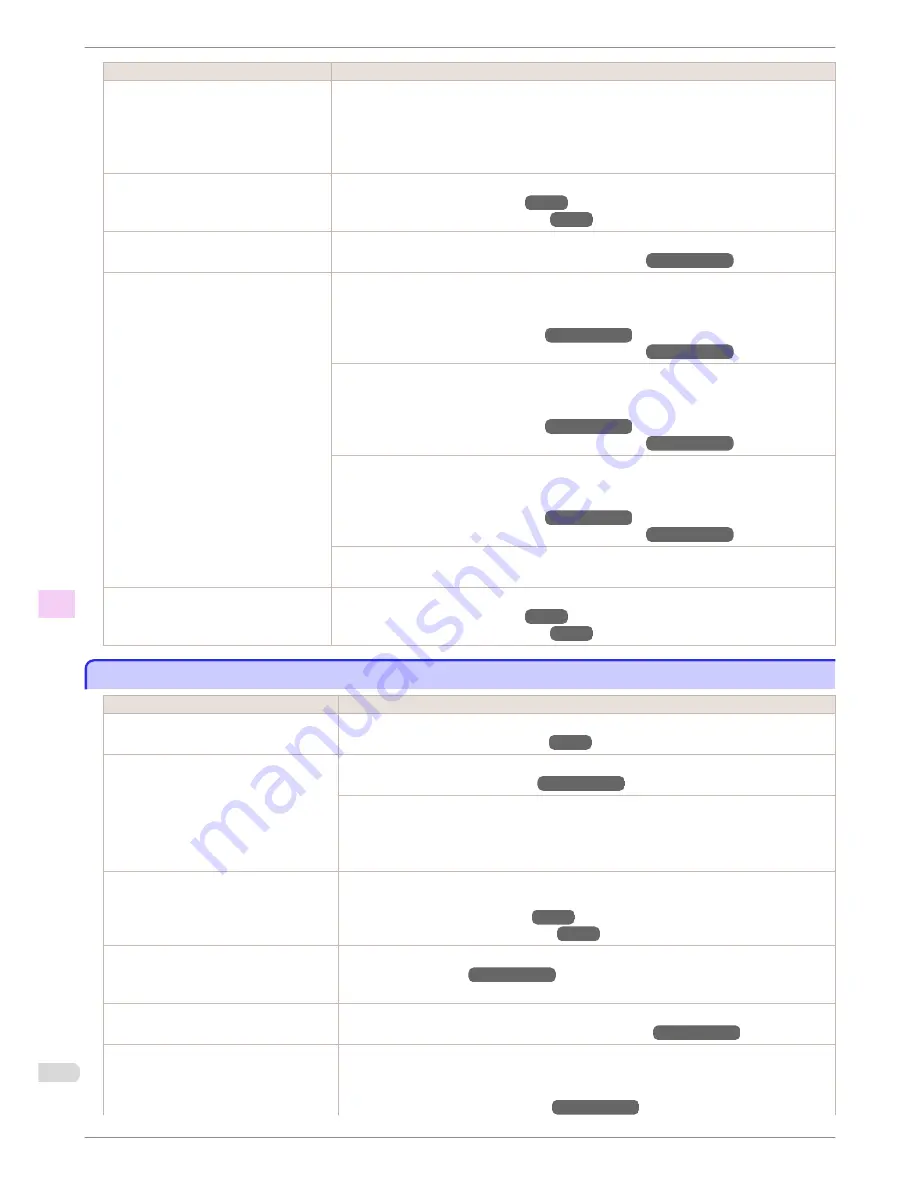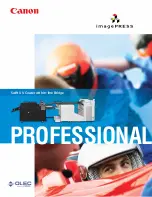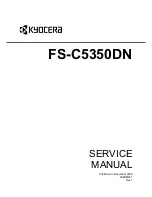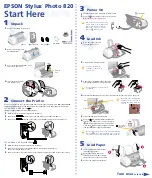
Cause
Corrective Action
The type of paper specified in the printer
driver does not match the type loaded in
the printer.
Make sure the same type of paper is specified in the printer driver as you have loaded in the
printer.
1.
Press the
Stop
button and stop printing.
2.
Change the type of paper in the printer driver and try printing again.
Paper has been loaded incorrectly, caus-
ing it to wrinkle.
Reload the paper.
(See "Loading Rolls in the Printer.")
→P.11
(See "Loading Sheets in the Feed Slot.")
→P.18
The Printhead is set too low in the Con-
trol Panel menu.
In the Control Panel menu, set
Head Height
to
Automatic
.
(See "Troubleshooting Paper Abrasion and Blurry Images.")
→User's Guide
You are printing on heavyweight paper
or paper that curls or wrinkles easily after
absorbing ink.
When printing on
Canon Heavyweight Coated Paper
or other paper-based media, choose a
VacuumStrngth
setting of
Strong
or
Strongest
in the Control Panel menu. If rubbing still oc-
curs, in the Control Panel menu, use a higher
Head Height
setting.
(See "Adjusting the Vacuum Strength.")
→User's Guide
(See "Troubleshooting Paper Abrasion and Blurry Images.")
→User's Guide
When printing on
CAD Tracing Paper
or other film-based media, choose a
VacuumStrngth
setting of
Standard
,
Strong
, or
Strongest
in the Control Panel menu. If rubbing still occurs, in
the Control Panel menu, use a higher
Head Height
setting.
(See "Adjusting the Vacuum Strength.")
→User's Guide
(See "Troubleshooting Paper Abrasion and Blurry Images.")
→User's Guide
When printing on paper 0.1 mm (0.004 in) thick or less, choose a
VacuumStrngth
setting of
Weakest
in the Control Panel menu. If rubbing still occurs, in the Control Panel menu, use a
higher
Head Height
setting.
(See "Adjusting the Vacuum Strength.")
→User's Guide
(See "Troubleshooting Paper Abrasion and Blurry Images.")
→User's Guide
If edges of the paper curl and become soiled when printing on rolls of glossy photo paper, in
Paper Detailed Settings
in the printer driver, set
Near End Margin
to
20mm
.
When you have loaded paper, the paper
you have loaded does not match the
type selected on the Control Panel.
Be sure to select the correct type of paper in the Control Panel menu when loading paper.
(See "Loading Rolls in the Printer.")
→P.11
(See "Loading Sheets in the Feed Slot.")
→P.18
The edges of the paper are dirty
The edges of the paper are dirty
Cause
Corrective Action
The Platen has become dirty after border-
less printing or printing on small paper.
Open the Top Cover and clean the Platen.
(See "Cleaning Inside the Top Cover.")
→P.51
The type of paper as specified on the
printer does not match the type specified
in the printer driver.
Make sure the same type of paper is specified on the printer as in the printer driver.
(See "Changing the Type of Paper.")
→User's Guide
Make sure the same paper type is specified in the printer driver as on the printer.
1.
Press the
Stop
button and stop printing.
2.
Change the type of paper in the printer driver and try printing again.
The paper is wrinkled or warped.
Straighten out the wrinkles or curls and reload the paper. Do not use paper that has been
printed on previously.
(See "Loading Rolls in the Printer.")
→P.11
(See "Loading Sheets in the Feed Slot.")
→P.18
A cut line is printed because
CutDustRe-
duct.
is
On
in the Control Panel menu to
reduce cutting dust.
If this function is not needed, set
CutDustReduct.
to
Off
in the Control Panel menu.
(See "Menu Settings.")
→User's Guide
The Printhead is set too low in the Control
Panel menu.
In the Control Panel menu, set
Head Height
to
Automatic
.
(See "Troubleshooting Paper Abrasion and Blurry Images.")
→User's Guide
You are printing on heavyweight paper or
paper that curls or wrinkles easily after ab-
sorbing ink.
When printing on
Canon Heavyweight Coated Paper
or other paper-based media, choose a
VacuumStrngth
setting of
Strong
or
Strongest
in the Control Panel menu. If rubbing still
occurs, in the Control Panel menu, use a higher
Head Height
setting.
(See "Adjusting the Vacuum Strength.")
→User's Guide
The edges of the paper are dirty
iPF6450
Basic Guide
Troubleshooting
Problems with the printing quality
114
















































